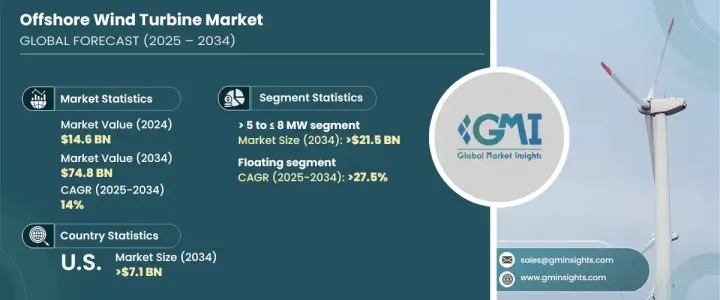PUBLISHER: Global Market Insights Inc. | PRODUCT CODE: 1684850

PUBLISHER: Global Market Insights Inc. | PRODUCT CODE: 1684850
Offshore Wind Turbine Market Opportunity, Growth Drivers, Industry Trend Analysis, and Forecast 2025 - 2034
The Global Offshore Wind Turbine Market reached USD 14.6 billion in 2024 and is projected to expand at a robust CAGR of 14% from 2025 to 2034. Offshore wind turbines, which harness the power of wind to generate electricity, are typically installed in large bodies of water such as oceans or large lakes. These turbines are designed to withstand the harsh marine environment and are mounted on either floating platforms or fixed foundations, depending on the water depth. The growing transition to renewable energy is a key factor driving market expansion as governments and corporations increasingly prioritize sustainable energy solutions.

Along with supportive policies promoting offshore wind initiatives, the rising demand for clean energy sources and investments from both private and public sectors are accelerating the adoption of offshore wind technologies. The drive for energy diversification, spurred by fluctuations in energy prices and geopolitical uncertainties, is pushing nations to seek more reliable and sustainable power generation options. Technological innovations are enhancing the efficiency of turbines, reducing costs, and improving overall performance. Additionally, advancements in grid integration and energy storage solutions are helping optimize the distribution of wind energy, further strengthening the market's potential.
| Market Scope | |
|---|---|
| Start Year | 2024 |
| Forecast Year | 2025-2034 |
| Start Value | $14.6 Billion |
| Forecast Value | $74.8 Billion |
| CAGR | 14% |
When it comes to the turbines' rating, the market is segmented into various categories, with turbines ranging from <= 2 MW to > 12 MW. The > 5 to <= 8 MW segment is expected to generate USD 21.5 billion by 2034. This category of turbines delivers higher power outputs, making them more cost-effective and reducing project costs per megawatt-hour. The demand for these turbines is driven by their superior efficiency and their ability to operate at a lower levelized cost of energy. As a result, they are gaining popularity, particularly in areas where offshore wind conditions are less extreme. Manufacturers are continuing to focus on optimizing the performance, durability, and flexibility of these turbines, making them more competitive in the market.
The floating offshore turbines segment is anticipated to experience the highest growth rate, with a CAGR of 27.5% by 2034. These floating turbines are capable of operating in deep waters where fixed-bottom models are not feasible, unlocking a wealth of untapped offshore wind potential. Innovations in floating turbine designs, including semi-submersible, spar buoy, and tension-leg platforms, are improving both cost efficiency and stability. The ability to deploy these turbines in deeper waters expands the range of opportunities for offshore wind projects, especially in regions with limited shallow-water resources.
The US offshore wind turbine market is also set for substantial growth, with a projected market value of USD 7.1 billion by 2034. Government incentives, including investment and production tax credits, are fueling this expansion. Strategic initiatives at the state level are pushing forward wind energy projects as the US works toward its ambitious renewable energy targets. Advances in floating turbine technology are paving the way for offshore wind farms in deeper waters, further propelling market growth and solidifying offshore wind as a cornerstone of the US renewable energy landscape.
Table of Contents
Chapter 1 Methodology & Scope
- 1.1 Market definitions
- 1.2 Base estimates & calculations
- 1.3 Forecast calculation
- 1.4 Primary research & validation
- 1.4.1 Primary sources
- 1.4.2 Data mining sources
- 1.5 Market Definitions
Chapter 2 Executive Summary
- 2.1 Industry synopsis, 2021 – 2034
Chapter 3 Industry Insights
- 3.1 Industry ecosystem
- 3.2 Regulatory landscape
- 3.3 Industry impact forces
- 3.3.1 Growth drivers
- 3.3.2 Industry pitfalls & challenges
- 3.4 Growth potential analysis
- 3.5 Porter's analysis
- 3.5.1 Bargaining power of suppliers
- 3.5.2 Bargaining power of buyers
- 3.5.3 Threat of new entrants
- 3.5.4 Threat of substitutes
- 3.6 PESTEL analysis
Chapter 4 Competitive landscape, 2024
- 4.1 Introduction
- 4.2 Strategic dashboard
- 4.3 Innovation & sustainability landscape
Chapter 5 Market Size and Forecast, By Rating, 2021 – 2034 (USD Million & MW)
- 5.1 Key trends
- 5.2 ≤ 2 MW
- 5.3 > 2 to ≤ 5 MW
- 5.4 > 5 to ≤ 8 MW
- 5.5 > 8 to ≤ 10 MW
- 5.6 > 10 to ≤ 12 MW
- 5.7 > 12 MW
Chapter 6 Market Size and Forecast, By Installation, 2021 – 2034 (USD Million & MW)
- 6.1 Key trends
- 6.1.1 Floating
- 6.1.2 Fixed
- 6.1.2.1 Axis
- 6.1.2.1.1 HAWT
- 6.1.2.1.1.1 Up-Wind
- 6.1.2.1.1.2 Down-Wind
- 6.1.2.1.2 VAWT
- 6.1.2.1.1 HAWT
- 6.1.2.2 Component
- 6.1.2.2.1 Blades
- 6.1.2.2.2 Towers
- 6.1.2.2.3 Others
- 6.1.2.1 Axis
Chapter 7 Market Size and Forecast, By Region, 2021 – 2034 (USD Million & MW)
- 7.1 Key trends
- 7.2 North America
- 7.2.1 U.S.
- 7.2.2 Canada
- 7.3 Europe
- 7.3.1 Germany
- 7.3.2 Spain
- 7.3.3 UK
- 7.3.4 France
- 7.3.5 Italy
- 7.3.6 Sweden
- 7.3.7 Poland
- 7.3.8 Denmark
- 7.3.9 Portugal
- 7.3.10 Netherlands
- 7.3.11 Ireland
- 7.3.12 Belgium
- 7.4 Asia Pacific
- 7.4.1 China
- 7.4.2 India
- 7.4.3 Australia
- 7.4.4 Japan
- 7.4.5 South Korea
- 7.4.6 Vietnam
- 7.4.7 Philippines
- 7.4.8 Taiwan
- 7.5 Rest of World
Chapter 8 Company Profiles
- 8.1 Bergey Windpower
- 8.2 CSSC
- 8.3 Doosan Corporation
- 8.4 ENERCON
- 8.5 ENESSERE
- 8.6 Envision Group
- 8.7 EOLINK
- 8.8 General Electric
- 8.9 Goldwind
- 8.10 Mingyang Smart Energy Group
- 8.11 NORDEX
- 8.12 Orsted
- 8.13 Senvion
- 8.14 Siemens Gamesa Renewable Energy
- 8.15 Suzlon Energy Limited
- 8.16 Vattenfall
- 8.17 Vestas
- 8.18 WEG




